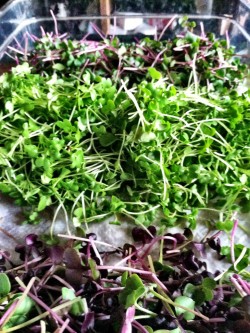All About Food | April 6th, 2016

I got a chance to sit down with Paul P. “Pete” Nielson to talk about his business, Dirt Head Farms, urban farming, his crowdsourcing campaign, and next steps.
Nielson just launched a GoFundMe campaign to purchase start-up equipment to expand the business beyond micro greens. Money raised will be used to purchase a tiller, tarps, a flame weeder, and other items needed for farming. These items are crucial for starting the urban farm. Nielson says that eventually the building of a passive heated greenhouse will help extend the growing season and produce availability.
Nielson’s micro greens include: broccoli, arugula, hong vit radish, red arrow radish, red garnet mustard, pea shoots, sunflower shoots, red Russian kale, albino sweet corn shoots, kohlrabi, anise, celery, daikon radish, basil, and amaranth.
He also recently announced the possibility of a Community-Supported Agriculture (CSA) for microgreens from May-June.
High Plains Reader: What are micro greens?
Pete Nielson: People confuse sprouts and microgreens. Microgreens are grown in the dirt. Sprouts are grown in water. Microgreens are the first set of leaves – that first growth before the full leaves come. The most popular microgreens currently are broccoli, arugula, and radish greens. The brassica family grows well in cool weather, so they can go in the ground early in the season. Micro greens usually take seven to ten days to harvest – but I have harvested some in as short a time as six days.
Broccoli microgreens are very popular, and Swanson’s Health Products sells Dirt Head’s greens, primarily because of the cancer-fighting properties. Everyone goes nuts for the broccoli microgreens because of the cancer fighting reputation. I also want people to try other microgreens. If people demand a new flavor, I’ll supply it.
HPR: How will your CSA work?
Nielson: I just announced a potential CSA on the Dirt Head Micro Greens Facebook site to see if there is enough interest. I am looking for at least 20 customers, and I can handle up to 40. It would be in May and June, ending just before the downtown Red River Market opens, so people can get their spring green fever needs taken care of. It would be four ounces of greens every week for eight weeks for $75, or $100 if you want it delivered to your home or office. Four ounces of micro greens is usable for a week – and would be enough for any sandwiches for lunch, to add them to salads -- or with lake season coming, bring some micro greens to the lake. Delivery and pick up would be on Thursdays. Andrea Baumgartner at Bernbaum’s Bagels has agreed to allow me to use them as a pick-up spot.
HPR: Tell us about your micro green growing process and how you got started.
Nielson: Two years ago I made my first delivery of micro greens to Usher’s House and Beefsteak. I currently grow Dirt Head Micro Greens in the basement of my house. I am looking to expand through urban farming, finding spaces in people’s back yards and other places that are suitable for growing. I need spaces that are 2,000 square feet or bigger. When I look for places to grow, I first ask, can I grow on it? Do I have access to it? How far do I have to travel? And, very importantly, does the space have water? There are some great spaces along the river but there is no access to water, unfortunately.
Some of the businesses that use Dirt Head Micro Greens include the HoDo, Swanson’s, Proof, the Toasted Frog, and Blackbird Woodfire Pizza.
I cooked in restaurants for seventeen years. I had some discussions with friends about aquaponics, and I started thinking about indoor growing. The idea of growing micro greens grew out of wanting to make better food for our area. And microgreens are a great way to start because of the quick turnaround time. And they are a great product!
HPR: Tell us about urban farming and the importance of growing organic, quality produce.
Nielson: Fargo has never seen anything like urban farming. It is a new concept for Fargo, but is very popular in Minneapolis-St. Paul, and many other places. I am going to use my back yard and eventually, I hope, my front yard. I want to move the business to an actual facility that would have a wash pack and a cooler.
Everyone should access to good food. Organic food is expensive – but cancer is expensive, to use a quote from Michael Pollan’s “In Defense of Food” from the farmer Joel Salatin. Salatin asks, “What would you rather pay for, organic food or cancer?” When I read “The Omnivore’s Dilemma” by Michael Pollan, it really opened my eyes to food and food politics.
I want to go to the next step which is an urban farm. As of right now I want to stay in Fargo. I want to use Fargo to do this. Along with growing micro greens, my next step is to grow other good-quality produce. My first place to sell to is restaurants, but overall I want to see people have good access to high-quality food for as long as possible in the season.
I want to bring spring greens in the middle of winter to our area, so the food does not have to travel from California to North Dakota. That road trip is really hard on produce. We can do it here. And we can do it for a good price.
YOU SHOULD KNOW
CONTACT: pete@dirtheadmicrogreens
TO SUPPORT: https://www.gofundme.com/www-dirtheadfarms
SOCIAL MEDIA: https://www.facebook.com/dirtheadmicrogreens/
November 18th 2025
November 12th 2025
September 16th 2025
August 19th 2025
July 15th 2025

__293px-wide.jpg)
__293px-wide.jpg)
_(1)__293px-wide.jpg)
__293px-wide.jpg)
